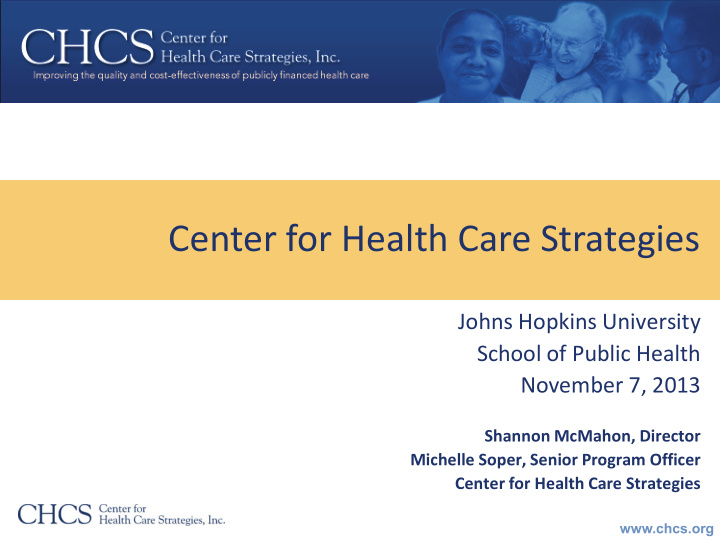



Center for Health Care Strategies Johns Hopkins University School of Public Health November 7, 2013 Shannon McMahon, Director Michelle Soper, Senior Program Officer Center for Health Care Strategies www.chcs.org
A non-profit health policy resource center dedicated to improving health care services for Americans receiving publicly financed care ► Priorities : (1) enhancing access to coverage and services; (2) improving quality/delivery system reform; (3) integrating care for people with complex needs; and (4) building Medicaid leadership and capacity. ► Provides: technical assistance for stakeholders of publicly financed care, including states, health plans, providers, and consumer groups; and informs federal and state policymakers regarding payment and delivery system improvement. ► Funding: philanthropy and the U.S. Department of Health and Human Services. 2
Select CHCS National Initiatives Building Improving Enhancing Access Integrating Care for Medicaid Quality/Delivery to Coverage and People with Leadership System Reform Services Complex Needs and Capacity Complex Care State Innovation Innovation Lab Medicaid Leadership Model Resource State Health Reform Institute Center* Integrated Care Assistance Network Resource Center – California Department Aligning Forces for Dual Eligible of Health Care Charity Care Affinity Quality Demonstrations* Group Services Academy Advancing Medicaid Medicaid Health Accountable Care Homes Program Organizations: A Design* Learning Collaborative 3 *Federally-funded initiatives
Examples of CHCS Projects Complex Care Innovation Lab – Convening national health care innovators to explore ways to improve services for the highest-need, highest-cost individuals receiving publicly financed health care. ► REACH : 11 innovative organizations in 10 states and Washington, DC State Innovation Model – Working with states to design and/or test their models for statewide care delivery and payment reform aligning with the Triple Aim of improved health, improved patient experience, and reduced costs. ► REACH : 25 states, ≈ 43 million beneficiaries Medicaid Leadership Institute – Enhancing the leadership capacity of competitively selected Medicaid directors to help them transform their programs into national models for high-quality, cost-effective care. ► REACH : 22 states, 40 million beneficiaries; representing roughly 2/3 of the nation’s total Medicaid population. 4
CHCS is leading national Medicaid efforts to: ► Improve access and coverage to Medicaid services particularly for vulnerable populations. ► Instill value-based purchasing principles and reward quality. ► Develop innovative care models for the highest-need, highest- cost patients with multiple chronic illnesses. ► Integrate Medicaid and Medicare services and financing for the dual eligibles. ► Leverage the program’s purchasing strength to help drive quality improvements across public and commercial payers.
Why States? • States can be a driving force because they ► Pay for a large percentage of health care and have a major stake in reducing avoidable costs ► Have regulatory powers over providers and payers ► Administer/regulate public health and social services ► Can integrate state health information exchange infrastructure ► Can convene multiple parties 6
Medicaid: Many Vital Roles in Our Health Care System Health Insurance Coverage Long-Term Care Assistance to Medicare Assistance 31 million children and 16 million Beneficiaries adults in low-income families; 16 1.6 million institutional million elderly and persons with 9.4 million aged and disabled — residents; 2.8 million disabilities 20% of Medicare beneficiaries community-based residents MEDICAID State Capacity for Health Coverage Support for Health Care System and Safety-Net Federal share ranges 50% to 83%; For 16% of national health spending; 40% of long- FFY 2012 ranges from 50% to 74.2% term care services SOURCE: Kaiser Commission on Medicaid and the Uninsured, 2012. 7
Medicaid Basics: Program Size & Expenditures Note: This assumes all states expand Medicaid by 2020 S OURCE : Centers for Medicare & Medicaid Services, National Health Expenditure Projections 2010-2020, 2011. p.2 available at: https://www.cms.gov/Research-Statistics- Data-and-Systems/Statistics-Trends-and-Reports/NationalHealthExpendData/downloads/proj2010.pdf 8
Medicaid ‘s Growing Role as a Powerful Purchaser • With the Medicaid expansion, there are new powerful incentives for Medicaid to become a smarter purchaser ► Federal and state budget pressures and imperatives ► Medicaid stakeholders frequently look to the Triple Aim as they consider policy changes – health care that is delivered at the right time, in the right setting, achieving the right outcome ► National efforts to contain cost look toward multipayer strategies: Medicare, Medicaid, private market coverage (e.g., State Innovation Models) • Medicaid is a major driver of these imperatives and will continue to be looked to as a place to deliver value through smarter purchasing strategies Source: Centers for Medicare & Medicaid Services, National Health Expenditure Projections 2011-2021, 2012. p.2 available at: http://www.cms.gov/Research-Statistics- Data-and-Systems/Statistics-Trends-and-Reports/NationalHealthExpendData/Downloads/Proj2011PDF.pdf. 9
Medicaid’s Purchasing Power As the largest Poor health care 41% newborns Medicaid serves purchaser of health quality is an issue insurance, Medicaid more than 60 33% children for all Americans; can leverage its million however, the gap Many people with purchasing power to: Americans – is substantially chronic illnesses soon to be 80 greater for and disabilities Access performance million Medicaid data Many frail elderly beneficiaries Identify and address gaps in quality 10
Medicaid Fast Facts 67 million People in the United States with Medicaid coverage. $440 billion State and federal Medicaid spending for FY 2012. Additional Medicaid/CHIP beneficiaries after 2014, pending state decisions on 7 - 11 million Medicaid expansion. 41% Births in the United States covered by Medicaid. 1 in 3 Children in the United States covered by Medicaid. 57% Medicaid beneficiaries under 65 who are from diverse racial/ethnic groups. Medicaid beneficiaries, many with chronic illnesses and disabilities, accounting for 5% 55% of total Medicaid spending. 49% Medicaid beneficiaries with disabilities diagnosed with mental illness. 43% Total long-term care costs in the United States financed by Medicaid. 39% Percentage of Medicaid dollars spent on Medicare-Medicaid enrollees. 72% Medicaid recipients who are enrolled in managed care. 11 21
M EDICAID S TATE OF P LAY : States Expanding Coverage to Adults <138% FPL As of October 22, 2013. Source: Advisory Board. “Beyond the pledges: Where the states stand on Medicaid.” http://www.advisory.com/Daily-Briefing/Resources/Primers/MedicaidMap#lightbox/2/ 12
Recommend
More recommend